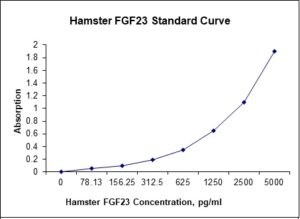Nori Hamster FGF23 ELISA Kit
$461.00 – $832.00
This ELISA kit is for quantification of FGF23 in hamster. This is a quick ELISA assay that reduces time to 50% compared to the conventional method, and the entire assay only takes 3 hours. This assay employs the quantitative sandwich enzyme immunoassay technique and uses biotin-streptavidin chemistry to improve the performance of the assays. An antibody specific for FGF23 has been pre-coated onto a microplate. Standards and samples are pipetted into the wells and any FGF23 present is bound by the immobilized antibody. After washing away any unbound substances, a detection antibody specific for FGF23 is added to the wells. Following wash to remove any unbound antibody reagent, a detection reagent is added. After intensive wash a substrate solution is added to the wells and color develops in proportion to the amount of FGF23 bound in the initial step. The color development is stopped, and the intensity of the color is measured.
Alternative names for FGF23: Fibroblast growth factor 23, HYPF, FGF8B
This product is for Laboratory Research Use Only not for diagnostic and therapeutic purposes or any other purposes.
- Description
- How Elisa Works
- Product Citation (0)
- Reviews (0)
Description
Nori Hamster FGF23 ELISA Kit Summary
Alternative names for FGF23: Fibroblast growth factor 23, HYPF, FGF8B
Alternative names for hamster: golden hamster, syrian hamster
| Assay Type | Solid Phase Sandwich ELISA |
| Format | 96-well Microplate or 96-Well Strip Microplate |
| Method of Detection | Colorimetric |
| Number of Targets Detected | 1 |
| Target Antigen Accession Number | A0A1U7QZ57 |
| Assay Length | 3 hours |
| Quantitative/Semiquantitative | Quantitative |
| Sample Type | Plasma, Serum, Cell Culture, Urine, Cell/Tissue Lysates, Synovial Fluid, BAL, |
| Recommended Sample Dilution (Plasma/Serum) | No dilution for sample <ULOQ; sufficient dilution for samples >ULOQ |
| Sensitivity | 15 pg/mL |
| Detection Range | 78-5000 pg/mL |
| Specificity | Hamster FGF23 |
| Cross-Reactivity | < 0.5% cross-reactivity observed with available related molecules, < 50% cross-species reactivity observed with species tested. |
| Interference | No significant interference observed with available related molecules |
| Storage/Stability | 4 ºC for up to 6 months |
| Usage | For Laboratory Research Use Only. Not for diagnostic or therapeutic use. |
| Additional Notes | The kit allows for use in multiple experiments. |
Standard Curve
Kit Components
1. Pre-coated 96-well Microplate
2. Biotinylated Detection Antibody
3. Streptavidin-HRP Conjugate
4. Lyophilized Standards
5. TMB One-Step Substrate
6. Stop Solution
7. 20 x PBS
8. Assay Buffer
Other Materials Required but not Provided:
1. Microplate Reader capable of measuring absorption at 450 nm
2. Log-log graph paper or computer and software for ELISA data analysis
3. Precision pipettes (1-1000 µl)
4. Multi-channel pipettes (300 µl)
5. Distilled or deionized water
Protocol Outline
1. Prepare all reagents, samples and standards as instructed in the datasheet.
2. Add 100 µl of Standard or samples to each well and incubate 1 h at RT.
3. Add 100 µl of Working Detection Antibody to each well and incubate 1 h at RT.
4. Add 100 µl of Working Streptavidin-HRP to each well and incubate 20 min at RT.
5. Add 100 µl of Substrate to each well and incubate 5-30 min at RT.
6. Add 50 µl of Stop Solution to each well and read at 450 nm immediately.
Background:
Fibroblast growth factor 23 (FGF23) is a protein that in humans is encoded by the FGF23 gene.[1] FGF23 is a member of the FGF family which is responsible for phosphate and vitamin D metabolism.[2][3] The main function of FGF23 seems to be regulation of phosphate concentration in plasma. FGF23 is secreted by osteocytes in response to elevated calcitriol. FGF23 acts on the kidneys, where it decreases the expression of NPT2, a sodium-phosphate cotransporter in the proximal tubule.[4] Thus, FGF23 decreases the reabsorption and increases excretion of phosphate. FGF23 may also suppress 1-alpha-hydroxylase, reducing its ability to activate vitamin D and subsequently impairing calcium absorption.[3] Mutations in FGF23 that render the protein resistant to proteolytic cleavage leads to increased activity of FGF23 and the renal phosphate loss found in the human disease autosomal dominant hypophosphatemic rickets. FGF23 is also overproduced by some types of tumors, such as the benign mesenchymal neoplasm Phosphaturic mesenchymal tumor causing tumor-induced osteomalacia, a paraneoplastic syndrome.[5] Loss of FGF23 activity is thought to lead to increased phosphate levels and the clinical syndrome of familial tumor calcinosis. This gene was identified by its mutations associated with autosomal dominant hypophosphatemic rickets.
References
- Yamashita T, et al. (2000). Biochem. Biophys. Res. Commun. 277 (2): 494–8.
- Fukumoto S (2008). Intern. Med. 47 (5): 337–43.
- Perwad F (2007). Am J Physiol Renal Physiol. 293 (5): F1577–83.
- Jüppner H (2011). “Phosphate and FGF-23”. Kidney Int. Suppl. 79 (121): S24–7.
- Zadik Y, Nitzan DW (2011). Oral Oncol. 48 (2): e9–10.
Be the first to review “Nori Hamster FGF23 ELISA Kit”
You must be logged in to post a review.




























Reviews
There are no reviews yet.